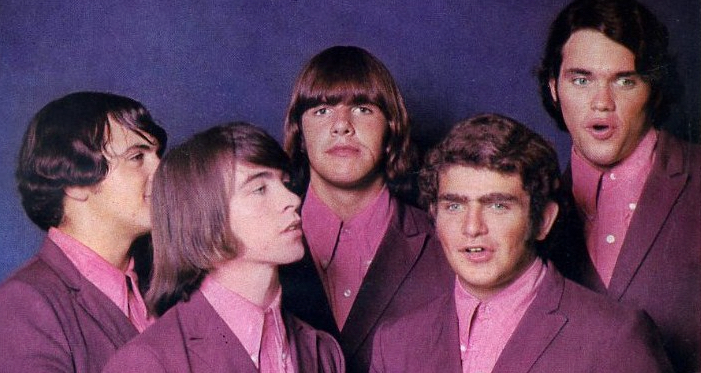
And it goes like this …
Stricken by the loss of his mother, teenager John “Sean” Byrne moved from Dublin, Ireland, to California, seeking a fresh start. He certainly got one.
Byrne, who came from a large musical family, moved in with his brother in south San Jose. Fate placed a garage band across the street. Byrne sat in, and immediately became a member, singing and playing rhythm guitar.
Part of a mid-’60s regional rock scene that included the Syndicate of Sound, Sean Bonniwell, singer Stevie Nicks and the Chocolate Watchband, the group looked for a marketing hook. The kids came up with vampire capes and a new name to match, the Counts. “We added the ‘Five’ part because we were all big fans of the Dave Clark Five,” Byrne said in 1994.
The band was mostly high schoolers. “We always did concerts on the weekends because we were too busy going to school during weekdays,” said John “Mouse” Michalski, who provided half of the twin guitar attack (with Byrne).
Count Five members said they ultimately lost a million dollars in bookings due to their dedication to studies, but the school days had come with a payoff. In early 1966, the band was trying to come up with for lyrics for a promising original instrumental. The story goes that Byrne was attending a class at San Jose City College, enduring a Ben Stein-like lecture on psychosis. A classmate told Byrne “psychotic reaction” would make a killer title for a rock song.
Byrne had the lyrics ready for the band the same night. They debuted it at a dance a few weeks later, where a local DJ was duly impressed and arranged for an audition with friends who were starting a record label in L.A. “Psychotic Reaction” proved the highlight of the audition and June saw its release as a single on Double Shot Records.
“Psychotic Reaction” picked up regional airplay, spread across the nation and by October hit No. 5 on the Billboard singles chart. Running about 3 minutes, the song startled listeners with its ferocity and garage band aesthetic: definitive fuzz guitar, howling harmonica and stomping-on-the-gym-floor drums. Our singer-narrator (Byrne) suffers from depression, brought on by what appears to be a clinical case of blue balls. He unleashes the cacophonic instrumental break by declaring: “And it feels like this!”
The acid-washed “Psychotic Reaction” was unusual for the pre-psychedelic era, but not unique. The rave-up instrumental passage and its fade-out reprise drew immediate comparisons with the Yardbirds.
The rock critic Dave Marsh later dismissed it as “one of the many ripoffs of the Yardbirds’ ‘I’m a Man.’ ”
Byrne always resented the comparison: “If you look at the records, the Yardbirds never came close to the popularity of ‘Psychotic Reaction,’ ” he told 60sgaragebands.com. (He had a point, sort of: The Yardbirds never cracked the Top 5 in the U.S., although they were close with two singles in 1965.) “I like the Yardbirds, but they did not influence ‘Psychotic Reaction.’ ” Hard to believe, but somehow the song does anticipate the British stars’ detour into psychedelic territory. (“Happenings Ten Years Time Ago” was four months away.)
From there, the story of Count Five seems pretty typical of 1960s one-hit-wonders: appearances on pop music showcases such as Dick Clark’s “American Bandstand”; a rushed cash-in album with underdeveloped originals and a couple of covers; no follow-up singles of note; hassles with management; and, eventually, a breakup as members wandered off to college, seeking shelter from the draft.
Yet count Count Five among the living dead, thanks in large part to a couple of rock critics.
In 1971, Lester Bangs of Creem magazine wrote a now-famous piece called “Psychotic Reactions and Carburetor Dung” in which he dreamed up a fictional discography for the band. The counter-factual also provided the title for a posthumous book of Bangs’ writings in 1987.
After singing the praises of his favorite tracks on the (real) “Psychotic Reaction” album, Bangs writes about his “favorite,” the (bogus) third LP, “Cartesian Jetstream”: “It was truly exhilarating music, filled with the wild pulsebeat of creation.”
He was not as thrilled with the (fictional) second album, “Carburetor Dung,” “an undifferentiated wall of grinding noise and intermittent punctuation of glottal sowling gruntings.”
The critic weighed in on the real-life Yardbirds controversy, dubbing the Count Five song an “all-time slop-bucket copy.” It was a compliment.
More to the point, the next year, Elektra Records asked musician and writer Lenny Kaye to put together a hip and psychedelic collection of oldies. This at a time when radio silence enveloped all but the most golden of golden oldies. And so was born the double-album “Nuggets: Original Artyfacts from the First Psychedelic Era, 1965-1968.”
“Psychotic Reaction” led side 3 of the hugely influential rock collection, gobsmacking a new generation of listeners.
Liner notes: The Rock and Roll Hall of Fame included “Psychotic Reaction” on its list of “500 Songs That Shaped Rock & Roll.” … The song remains a sure-fire live cover. Among those caught in the act have been Tom Petty and the Heartbreakers, Patti Smith, the Residents and Television. … Movie credits for the song include “Drugstore Cowboy” and “Less Than Zero.” … Byrne later performed with a band called the Count. He died in 2008. … “Psychotic Reaction” wasn’t the first radio song with psychedelic elements, but it was close: It falls on the 1966 timeline about halfway between the seminal “Eight Miles High” and “Happenings Ten Years Time Ago.” Love’s raging “7 and 7 Is” came out a month after the Count Five song.
Great song till I read about this I totally forgot about it but I really think psychotic reaction still holds up well today in 2023 just an old man’s point of view.